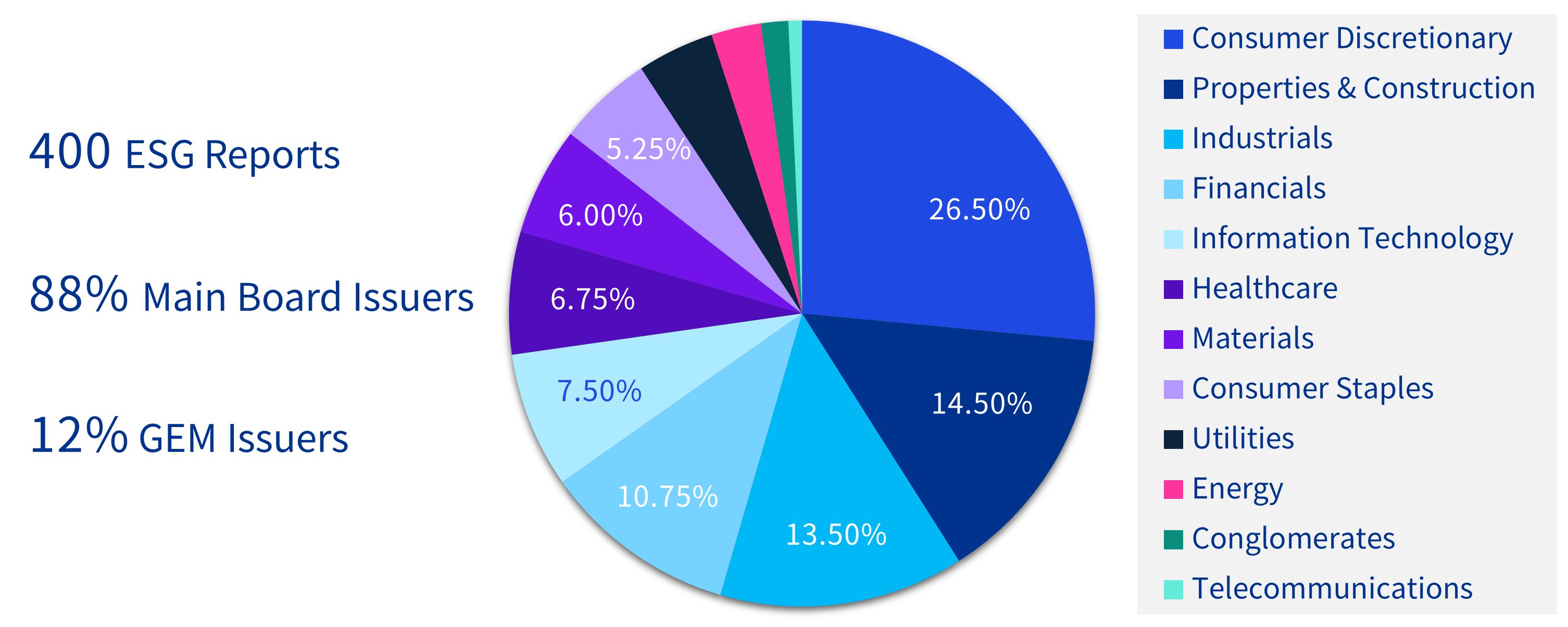1.Overview
On November 25, the Stock Exchange of Hong Kong Limited (“Exchange”) published the 2022 Analysis of ESG Practice Disclosure (“Review”). The Review analysed ESG reports for the financial year ended 30 June 2021, 31 December 2021 and 31 March 2022 published by a sample of 400 issuers (“Sample Issuers”) to assess the overall performance of the issuers in ESG reporting, which will also assist the issuers to improve their ESG information disclosure and promote the future ESG management.
The Review focuses on four aspects: board governance of ESG issues, climate change, social issues, and reporting practices, in order to respond to consideration and mitigation of significant climate change risks (“2020 Enhancements”) of the new ESG Reporting Guide (“ESG Rules”)1 revised by the Exchange in July 2020. The Exchange generally recognises the continuous progress made by issuers in ESG disclosure, but also pointed out that issuers still have deficiencies in ESG target review and climate risk disclosure, and expects issuers to continue to improve the quality of ESG reporting based on corresponding recommendations.
1 Appendix 27 (Environmental, Social and Governance Reporting Guide) of Main Board Listing Rules by the Exchange.
| Overview of the 2022 Review highlights |
|
2 In December 2021, the Exchange published Conclusions on Review of the Corporate Governance Code to require issuers to, among other things, publish ESG reports at the same time as publication of annual reports (“New Publication Requirement”).
Distribution of Sample Issuers

2.Details of the Reviews
2.1 Board governance of ESG issues
Observations of the Review
| Contents | Disclosure Rate | Observations |
| Board Statement | 76.8% | Progress Over 95% of issuers have disclosed their ESG governance structure or the roles and duties of designated working group or committee for ESG matters, and some have made use of flowcharts or diagrams to illustrate the corporate governance structure. A majority of Sample Issuers had disclosed ESG-related goals and targets (including specific targets under certain environmental KPIs).
Deficiencies Only around 40% of Sample Issuers disclosed how the board monitors the progress of ESG-related goals and targets set (failure to comply with this requirement would constitute a breach of the Listing Rules). |
| Board’s oversights of ESG Issues | 97.5% | |
| Board’s ESG management approach and strategy | 95.5% | |
| The process or approach adopted for the board’s progress review against ESG goals | approx. 40% |
Recommendations from Exchange
The board’s relevant processes, controls and procedures used to monitor and manage ESG matters This may involve elaboration on:
The process or approach adopted for the board’s progress review against ESG goals The discussion may include:
The results of the review against the targets
|
2.2 Climate change
Observations of the Review
| Contents | Disclosure Rate | Observations |
| Climate-related disclosure requirements | 85.0% | Progress A vast majority of Sample Issuers acknowledged the importance of climate-related risks and chose to make disclosures of all new climate-related requirements, including consideration of significant climate-related risks and mitigation measures; setting of certain environmental targets; and reporting on scope 1 and scope 2 greenhouse gas (“GHG”) emissions. Among those Sample Issuers who reported on targets pursuant to the relevant environment key performance indicators, more than two-thirds gave qualitative targets (i.e. directional, forward-looking statements). Deficiencies Only about 20% of Sample Issuers considered or referred to the TCFD recommendations when making climate disclosures. Premised on the TCFD recommendations, the International Sustainability Standards Board (“ISSB”) climate standards contemplate disclosures on scope 3 GHG emissions and climate-related scenario analysis, over a third of Sample Issuers disclosed scope 3 emissions, but less than 5% of Sample Issuers adopted climate-related scenario analysis in the Review. |
| Scope 1 and scope 2 emissions | 93.0% | |
| Environment key performance indicators | 93.8% | |
| TCFD recommendation adoption* | approx. 20% | |
| Scope 3 GHG emissions* | approx. 33% | |
| Climate-related scenario analysis* | less than 5% |
*Note: Currently not mandatory under the ESG Rules.
Recommendations from Exchange
Environmental targets
|
2.3 Social issues
Observations of the Review
| Contents | Disclosure Rate | Observations |
| B5.3: Practice to identify environmental and social risks along the supply chain | 84.8% | Progress
|
| B5.4: Green procurement | 67.8% | |
| B7.3: Anti-corruption training | 84.5% | |
| B5.3: Practice to identify environmental and social risks along the supply chain | 91.1% |
Recommendations from Exchange
|
ESG management in supply chain
|
2.4 Reporting practices
Observations of the Review
| Contents | Disclosure Rate | Observations |
| Materiality reporting principle | 93.0% | Progress Compared to the previous Review in 2018, issuers have a significant improvement in disclosure rate and quality of “Materiality”, “Quantitative” and “Consistency” Reporting Principles; Almost all Sample Issuers complied with the requirements to publish ESG reports within five months after the financial year end; 58% of them managed to publish their ESG reports on the same day as their annual reports, in advance of the New Publication Requirement becoming effective.
Regarding the application of “Quantitative” Reporting Principle, where Sample Issuers disclosed numerical figures in the ESG reports, some omitted to provide information on the standards, calculation methodologies, assumptions or conversion factors used for reporting. |
| Quantitative reporting principle | 84.3% | |
| Consistency reporting principle | 95.0% | |
| Publication timeline of ESG reports (the same time as the annual reports) | 58.0% | |
| Independent assurance | 6.7% |
Recommendations from Exchange
Application of Reporting Principles
|
3.Interpretation and recommendations from KPMG
Since 2016, when the Listing Rules required all issuers to publish an annual ESG report, the Exchange has been keeping abreast of the latest ESG trends at home and abroad, and has been improving the framework and rules of the ESG Rules to ensure that issuers can meet high level of ESG standards. Compared to previous reviews, this review focuses on the core content and disclosure difficulties of issuers, and the review comments reflect three trends.
| Substantive Impact | Issuers are required to fully explore the substantive impact of ESG on their business strategy and operations, including how it affects organisational performance and/or stakeholders over different cycles. |
| Effective management | Issuers are required to have an effective ESG management system in place to consider and address sustainability challenges, as well as to measure, monitor and drive continuous improvement in ESG performance. |
| Agile in action | Issuers should proactively understand and adopt the TCFD recommendations and ISSB standards to ensure that they are prepared for future ESG regulatory requirements. |
What do you need to know?
Given that most issuers are already in the 2022 financial year ESG reporting cycle, KPMG advises listed issuers to plan their ESG disclosure strategies, workflows and enhancements in advance, taking into account the Exchange's current Review report. At the same time, given that the Exchange has included ESG regulatory requirements in the listing process, Hong Kong listing applicants should also assess their ESG management status and start to establish an ESG disclosure system in advance.
For listed issuers “More than compliance” |
The Review not only highlights existing ESG regulatory priorities, but also looks ahead to the "way forward" (review of the existing ESG framework and enhancements to issuers' climate disclosure, etc.). In addition to ensuring compliance with existing requirements, issuers should:
|
For listing issuers “Rome is not built in a day” |
The HKEX Guidance Letter (HKEX-GL86-16) has explicitly requested listing applicants to establish ESG mechanisms in advance to enable them to comply with the ESG regulatory requirements of the Exchange upon listing. KPMG notes that the Exchange has also recently increased its focus on ESG governance, ESG objectives, climate risk and other key points of this Review in its enquiries with some applicants. Listing applicants should start at an early application stage to:
|
What do you need to focus on?
KPMG recommends that Hong Kong listed issuers and applicants focus further on the following four areas in the preparation of ESG reports or disclosures.
| Business and strategy |
|
| ESG-related risk |
|
| Goals and progress |
|
| Climate-related disclosure |
|
Contact us
Wei Lin
Partner, Head of Environmental, Social and Governance
KPMG China
wei.lin@kpmg.com
Anthony Ng
Partner, ESG Reporting and Assurance
KPMG China
anthony.ng@kpmg.com
Catherine Chung
Associate Director, ESG Reporting and Assurance
KPMG China
catherine.chung@kpmg.com
Patrick Chu
Partner, National Head of ESG Reporting and Assurance
KPMG China
patrick.chu@kpmg.com
Irene Chu
Partner, ESG Reporting and Advisory
KPMG China
irene.chu@kpmg.com
Laura Yang
Associate Director, ESG Reporting and Assurance
KPMG China
laura.yang@kpmg.com
Brenda Wang
Partner, ESG Reporting and Assurance
KPMG China
brenda.wang@kpmg.com
Eddie Ng
Partner, ESG Reporting and Assurance
KPMG China
eddie.ng@kpmg.com
Haoran Li
Associate Director, ESG Reporting and Assurance
KPMG China
haoran.li@kpmg.com

